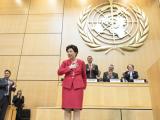Sep 4, 2009
Britain scales back flu death projection
The British government scaled back its projection of how many novel H1N1 deaths could occur, The Times of London reported today. In July it predicted 65,000 fatalities in a worst-case-scenario, but now the National Health Service (NHS) says fatalities could range between 3,000 and 19,000. Officials lowered the estimate because the symptoms of the virus are mild for most patients. The NHS's chief medical officer said case numbers have not risen in Scotland, where school resumed 3 weeks ago.
http://www.timesonline.co.uk/tol/news/uk/health/Swine_flu/article6820841.ece
Sep 4 Times story
Tiered epidemic plans could improve response
Responses to the novel H1N1 virus outbreak might be seen as alarmist, because many pandemic plans accounted for only a worst-case scenario, Peter Doshi, a doctoral student at Massachusetts Institute of Technology wrote in the British Medical Journal yesterday. Calibrated responses based on four types of risk assessments that take into account disease distribution and severity could build public trust and engage the public's attention to warning messages, he wrote.
http://www.eurekalert.org/pub_releases/2009-09/bmj-wtp090309.php
Sep 3 British Medical Journal press release
Uninsured New Jersey residents to get free pandemic flu vaccine
In announcing new measures to curb the fall wave of pandemic flu, New Jersey officials said yesterday that the state will provide free novel H1N1 vaccine to the 1.3 million uninsured people. The free vaccines will be offered though public health clinics located in all New Jersey counties. Other response measures include a public education campaign, working with school districts to keep schools open, and partnering with districts to establish a voluntary vaccination program.
Lung tissue in some fatal cases resembles H5N1 infection
Pathologic investigation of lung tissue from patients who have died of pandemic H1N1 infections resembles that in those dying from H5N1 avian influenza, a scientist who has studied about 70 fatal cases told the Canadian Press. Dr Sherif Zaki, a pathologist at the US Centers for Disease Control and Prevention said the level of lung damage makes it difficult to oxygenate patients. About a third of the patients had bacterial coinfections, and about 90% had underlying conditions such as obesity.
Doctors reverse severe infection with experimental IV antiviral
A 22-year-old woman with pandemic H1N1 infection and chemotherapy-induced immune compromise recovered from a severe infection after treatment with an experimental intravenous version of zanamivir, her doctors reported today in The Lancet. She had not responded to oseltamivir or nebulized zanamivir alongside antibiotics, hydrocortisone, and mechanical ventilation. Her doctors combined IV zanamivir with corticosteroids, which is controversial but is used in some respiratory distress cases.
http://www.thelancet.com/journals/lancet/article/PIIS0140-6736(09)61528-2/fulltext
Sep 4 Lancet report
WHO: flu activity increasing in many tropical regions
In its weekly pandemic update today, the World Health Organization (WHO) said flu activity is widespread and increasing in many tropical regions of South and Southeast Asia as well as South America. Though flu activity is past its seasonal peak in some parts of the southern hemisphere, parts of Australia and South America are seeing sustained circulation. Japan is experiencing an early start to its flu season. The global number of deaths is at least 2,837, mostly from WHO's Americas-region countries.
http://www.who.int/csr/don/2009_09_04/en/index.html
WHO pandemic update 64




















